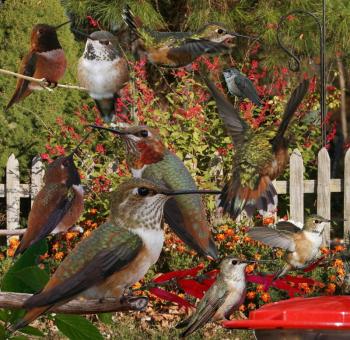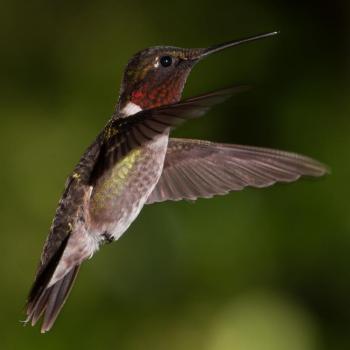Mystery Hummingbird: Piecing Together the Clues
Cousin Lisa, who lives in Boothbay, has sent us some interesting bird photos of late. She sent one of an albino common raven that a friend had seen in northern Maine. That must have been a ghostly shock to see in real life!
This week she sent a photo she took of a hummingbird in a neighbor’s yard in Boothbay.
The photo may have been taken with a cell phone as fine details are a bit hard to make out but it appears to be showing distinct orangey-rufous colors down in the tail. Those are colors you wouldn’t expect to see on our familiar ruby-throated hummingbird, whether it were male or female, young or old. We were about to head out to try and see it when Lisa reported that, unfortunately, the bird hadn’t been seen that day (the same day we received the photo). We would have enjoyed studying it ourselves.
We will, of course, ask if she or her neighbor captured any additional photos to clarify the bird’s identity. We may never know the answer to what it was for sure, but we did our best to piece together the evidence to make our best guess.
Maine has been host to at least three species of hummingbird in addition to the beloved ruby-throated hummingbirds that so many people enjoy throughout the state from May through September (occasionally into October). There is a single record of the large Mexican violetear and three records of the tiny calliope hummingbird. Neither of these species would be expected to show significant rufous in the tail.
The third of the rare hummingbird species that have been documented in Maine is the rufous hummingbird. We use the word “documented” very purposely here. That’s because immature and female Allen’s hummingbirds are virtually identical to and therefore are incredibly hard to differentiate from rufous hummingbirds Both can have significant rufous color at the base of the tail, and the differences between the two come down to the shape of certain tail feathers. You can imagine how hard that is to see on a tiny hummingbird! Both rufous and Allen’s hummingbirds are western species, the latter with a very restricted range along the Pacific coast of California to southern Oregon.
There are a handful of unequivocal records of male rufous hummingbirds as the males of the two species are generally straightforward to tell apart. There are also some records of females or immatures that have been captured or photographed and videotaped so extensively that those subtle tail feather differences were documented. Interestingly, there are a dozen or more additional records of birds that could be either rufous or Allen’s hummingbird, but there has not yet been a proven occurrence of an Allen’s hummingbird. Female and immature broad-tailed hummingbirds also have rufous in the tail, but that species has also never been confirmed (or even reported, as far as we know) to have occurred in Maine. Broad-tailed hummingbirds, like rufous and Allen’s, have been found across many eastern U.S. states outside of their normal range in the western U.S.
Most of the records of the rufous (or presumed rufous) hummingbirds in Maine have been from late July through October. Already this year, a rufous was seen and photographed in Pownal in late July.
There are still good numbers of ruby-throated hummingbird being reported around much of the state. If you see one that looks a little different than the others, it might be worth taking a closer look just as Cousin Lisa did!
Jeffrey V. Wells, Ph.D., is a Fellow of the Cornell Lab of Ornithology and Vice President of Boreal Conservation for National Audubon. Dr. Wells is one of the nation's leading bird experts and conservation biologists and author of the “Birder’s Conservation Handbook.” His grandfather, the late John Chase, was a columnist for the Boothbay Register for many years. Allison Childs Wells, formerly of the Cornell Lab of Ornithology, is a senior director at the Natural Resources Council of Maine, a nonprofit membership organization working statewide to protect the nature of Maine. Both are widely published natural history writers and are the authors of the popular books, “Maine’s Favorite Birds” (Tilbury House) and “Birds of Aruba, Bonaire, and Curaçao: A Site and Field Guide,” (Cornell University Press).

































